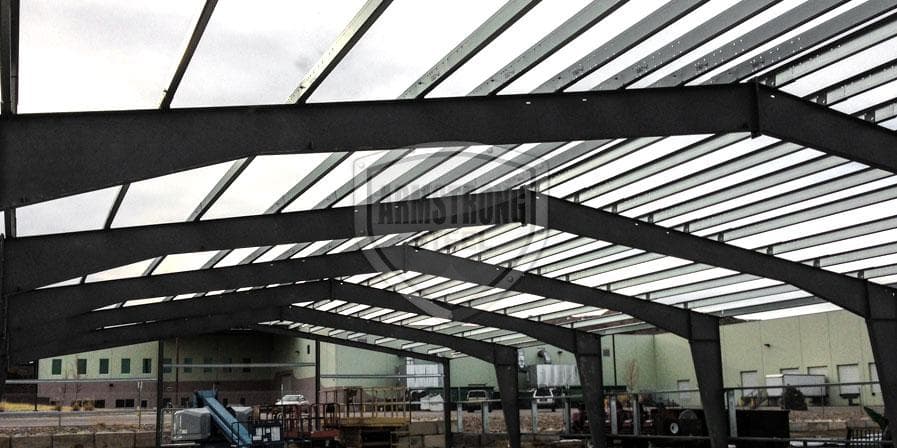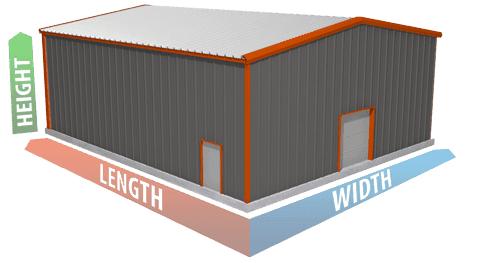Customer Profiles

RME's Building In Progress
Armstrong Steel Works to Find Solutions to a Contractor's Headaches
Sometimes it’s an internet search, often times it’s a referral, and more frequently than you might imagine, it’s our competitors who help customers discover the true value in working with Armstrong Steel.
This is the case with Rocky Mountain Excavating (RME). RME owner, Chris and RME Project Manager, Jeff, contacted steel building broker, General Steel, to start work on the office/workshop build-out for RME’s growing foundation company. The picture General Steel painted of Armstrong Steel was hardly complimentary.
“We would specifically ask every customer if they had spoken with anyone at Armstrong Steel and, if so, we would say that they were just a ‘sham operation’ or ‘operated out of a garage,’ ” says a former General Steel sales manager.
Chris and Jeff work in the construction industry and figured that if General Steel was mentioning another company by name – especially in a disparaging way – Armstrong obviously represented a serious competitive threat. RME wanted to know why General Steel even mentioned Armstrong Steel.
So RME did what every customer should do, they contacted Armstrong Steel directly.
“We invited Jeff to our corporate offices in the Denver Tech Center – hardly a ‘garage’ operation. We knew that our company and our reputation would sell itself,” says Eric Beavers, VP and COO of Armstrong Steel.
When Jeff arrived at Armstrong’s offices, he knew he was working with an industry powerhouse. “We showed [Jeff] around our offices; our bustling sales department, our project management team, he was introduced to our shipping department, and he got to explore some of our current projects with our in-house engineering department – the benchmark of Armstrong’s ability to deliver quality products to our clients,” continues Beavers.
As a construction professional, Jeff was accustomed to the process of detailing and engineering structures. He was given carte blanche to ask and discover, on his own, the capabilities of Armstrong Steel – from one professional organization to another. After several hours with the Armstrong team, he was sold. “We didn’t have to pressure Jeff; he made the decision to come to Armstrong because he liked what he saw. All of our building partners have a standing invitation to visit our corporate offices,” says Ethan Chumley, CEO and founder of Armstrong Steel.
An office/workshop combo is pretty standard for Armstrong Steel. “We design and deliver medium sized business build-outs as part of our routine, we know what these projects entail and we’ve streamlined our processes to help business owners receive their building on a timeline which doesn’t inhibit their ability to operate,” says Ethan Chumley.
Bureaucracy Sometimes Leads to Headaches
But the City of Castle Rock, Colorado, where the building was erected, would provide obstacles which required project management and navigation from the highest level of Armstrong’s team. “I took on the project management, personally, because this was an important job. It was critical that we painted a new picture for this customer that dispelled the concerns raised about us by General Steel. Mid-stream through RME’s permitting process, the permitting department for the City of Castle Rock was replaced by an ad hoc private company which basically threw out the previous engineering requirements the City provided,” says Eric Beavers.
The problematic issue was energy efficiency. “The new permitting agency was now requiring a new level of insulation in the workshop. Colorado winters can be cold and there's an effort state-wide to conserve energy but, traditionally, unheated workshops haven’t always required insulation,” says Beavers. “This meant that our insulation system needed to be redesigned to meet the new standards.”
This would cost RME time and money. “For any company, delays in a project can really tax budgets and impact timelines. I know this. Armstrong is a quickly growing business too, and I know that time costs money,” says Ethan Chumley. “But this is one of the biggest advantages to an in-house engineering department - we can make changes and modifications which save businesses time – and ultimately save them money.”
Chumley continues, “In my opinion, our in-house engineering department isn’t an indulgence. It’s a distinct advantage we provide our customers.”
Big Problems Come In Small Packages
Few construction projects, steel or otherwise, are ever completely without issues and one big issue, disguised as a small miscalculation, was discovered on-site. The big issue measured exactly six inches.
“RME needed an architect to work on the project because of extensive interior design,” says Beavers. “The architect was also the foundation engineer, and RME poured its own foundation, so we didn’t see it ahead of time. Somewhere along the way, the foundation was redesigned so the rigid frame would sit below the floor level by six inches; for whatever reason we did not redesign the rigid frame to be six inches longer – so it was too short. This is done for aesthetics, but six tiny inches can become an epic issue if the frame doesn’t fit on the foundation,” says Beavers.
Soon after RME took delivery of the building and began the erection process, the problem was discovered. Beavers was notified and within minutes, he raced to the job site. “When we promise that we’re going to be part of the building process from the initial sales call to the moment the final bolt is tightened in the erection process, we mean it,” remarked Beavers.
“To be honest, at first the customer was furious. I’m not going to sugar coat it. He’s a business owner, he works construction, and he had expectations. I didn’t show up on-site to offer apologies or excuses, we needed to be on-site to contribute to the solution.”
“Initially, the mood was tense. The customer was frustrated, the contractor was frustrated, and I was frustrated, but quickly, we decided that a solution needed to be found, there was no alternative. Instantly, the mood changed to one of cooperation and determination,” recalls Beavers.
Working in collaboration with the contractor, the customer, and Armstrong’s in-house design team, Beavers and the contractor arrived at an easy fix. “We’d be able to assemble a quick and sturdy extension into the foundation using extension bolts. The foundation wouldn’t need to be poured again, it wouldn’t require additional curing time to fill the holes, and the rigid frames wouldn’t need a major rework at the factory or on-site. The whole thing took less than a day.”
Solutions Not Excuses
“What this whole process shows is that our reputation speaks for itself,” says Ethan Chumley. “RME came to our office, just as every customer is invited to visit, he got to see first-hand what we’re capable of delivering. RME was able to navigate the murky waters of government bureaucracy quickly because our team was responsive, and when an issue arose on-site, we didn’t offer excuses or wash our hands of the situation – we dispatched our VP to arrive at a solution in person. I don’t need to gush over what our team did because it’s just pretty common for us to make that kind of effort.”
Whether the issue is one within our control – like design or delivery; or if the issue is one, which most steel companies consider the customer's problem – like permits and architects – the Armstrong team is ready to help find solutions.
If Armstrong was a ‘sham operation’ that ‘operated out of a garage,’ we wouldn’t be able to achieve this level of service. It happens because Armstrong’s a substantial business with robust purchasing power; we’ve built-up a name, we’ve built-up a reputation, and we’ve built-up a cohesive team – sometimes six tiny inches at a time.


